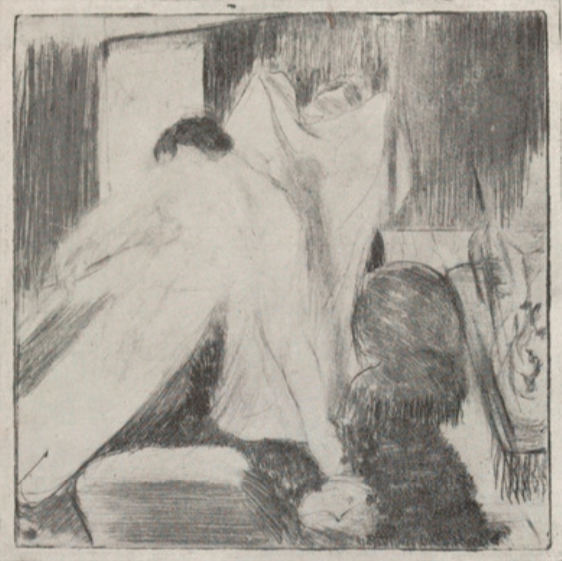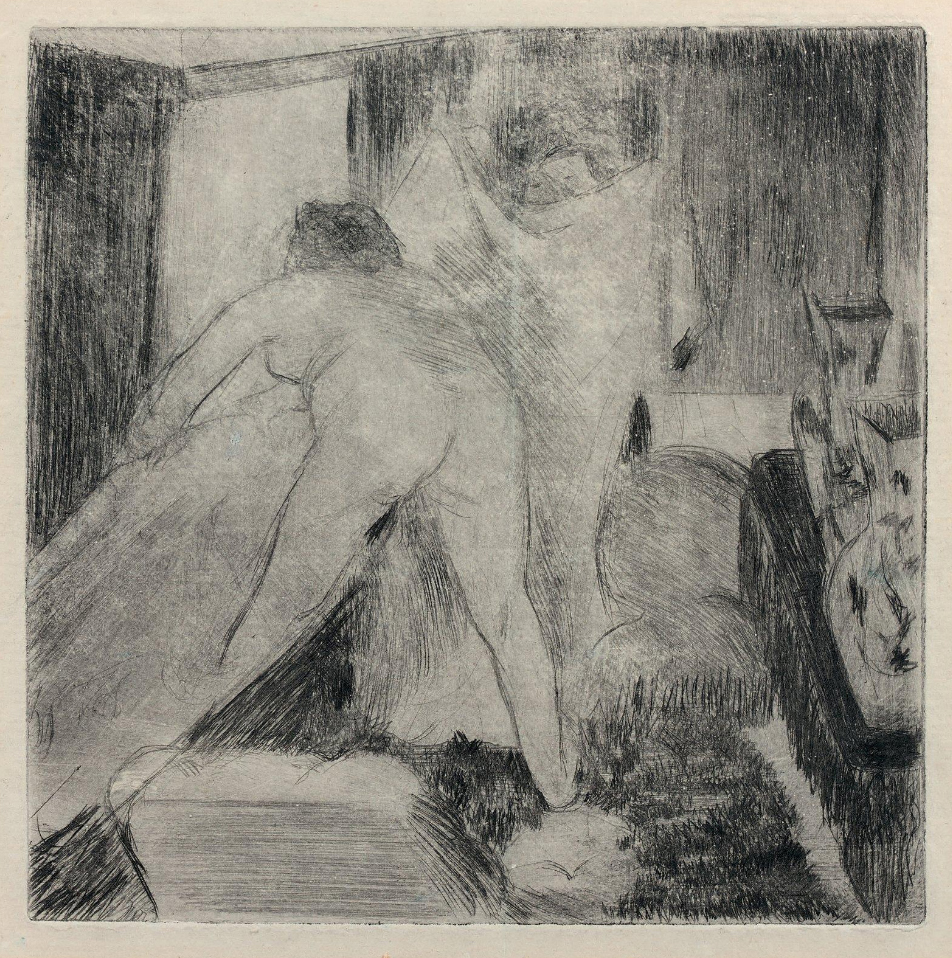
|
|
La Sortie du Bain
[Leaving the Bath]
Delteil 39 2nd state (of 17); Adhemar & Cachin 49 2nd state? (of 39); Reed & Shapiro 42, 2nd state (of 22)
aquatint etching (?), drypoint with burnishing,
circa 1879-1880 (or 1882, according to Delteil), an extremely rare*
early working proof (2nd state of 17 according to Delteil, or 2nd state
of 22, according to Reed and Shapiro) a very fine impression,
on medium-weight laid paper with the "Original/ Oxford Mill"
watermark (including the elaborate coat of arms), printed with subtle
plate tone and selective wiping, with
wide
margins, traces of a vertical central fold, a diagonal pinched printing crease along the reworked upper arm of the bather,
essentially visible on the verso, a narrow aureola of lightstaining
(recto) from an old mount along the outer margins, some skinning in the angles (verso), the top
right
corner missing, remains of old tape mounts above, on the verso,
otherwise in good condition, and with a prestigious
provenance from the 1918 Atelier sale**
P. 127x127 mm. S. 175x218 mm.
Provenance:
the 1918 Degas Atelier sale, with the red Atelier stamp (Lugt 657), verso, Lot 96 (see below)

|
In the 1870s,
Degas took up a number of new themes relating to the stage (dance and
theatre), to which he added in the latter half of the decade the more
intimistic theme of a woman at her bath, which he explored relentlessly
(see http://www.degas-catalogue.com/fr/catalogue.html).
This novel theme (see the Musée d'Orsay exhibition in
2012:
https://www.musee-orsay.fr/fr/expositions/presentation/degas-et-le-nu-196166) drew some scathing criticism at the time. As Gustave Geffroy (La Vie Artistique, Troisième série, Paris, 1894, pp. 168-9) commented,
C'est
bien la femme qui est là, mais une certaine femme, sans l'expression du
visage, sans le jeu de l'oeil, sans le décor de la toilette, la femme
réduite à la gesticulation de ses membres, à l'aspect de son corps, la
femme considérée en femelle, exprimée dans sa seule animalité, comme
s'il s'agissait d'un traité de zoologie réclamant une illustration
supérieure.
[It
is indeed the woman who is there, but a certain woman, without the
facial expression, without the play of the eye, without decorative
dress, the woman reduced to the gesticulation of her limbs, to the
aspect of her body, the woman considered as female, expressed only in
her animality, as if it were a treatise on zoology calling for a
superior illustration.]
Degas would surely have agreed, as he quipped to Alexis Rouart when showing him the new print, "Notre amie, Mme X... doit être ainsi, en sortant du bain." (in Löys Delteil, Le Peintre-Graveur Illustré, Tome 9, Paris, 1919).
The present
print is one of the most elaborate of all of his etchings, not so much by
its size but the daunting number of states, each with minute reworking, and it is clear the Degas
thought most highly of it, given the time he devoted to its completion
as well as the number of impressions that he kept in his atelier**,
especially since it was never formally editioned. This is also one
of the reasons for which it is so hard to define individual states.
In his catalogue raisonné, Loÿs Delteil
relates the apparently spontaneous creation of this print following
Degas's impromptu overnight
stay one sleety evening at Alexis Rouart's workshop on the boulevard Voltaire: waking the
next morning, the artist requested a copperplate and set to work
directly, with only a crayon électrique (or carbon rod***) in drafting the first state. This
"spontaneity" may however be tempered by the existence of an apparently
earlier pastelled monotype (1876-77), now in the Norton Simon Art
Foundation (https://www.nortonsimon.org/art/detail/M.1978.26.P),which
shows a quite similar scene (including, e.g., the armchair in the
foreground!), partially reversed.
now in the Norton Simon Art
Foundation (https://www.nortonsimon.org/art/detail/M.1978.26.P),which
shows a quite similar scene (including, e.g., the armchair in the
foreground!), partially reversed.
Because of its complexity, we have studied a number of early impressions.
The first state
(left,
from Delteil) was essentially a formal layout of the print,
though Degas was already refining tonal variants of space with
abundant fine shading. (Cf. the first-state impression in the Art
Institute of Chicago:
https://www.artic.edu/artworks/56104/leaving-the-bath)
Our impression
is closest to the "unique" second state impression, now in the Fine
Arts Museums of San Francisco, which is also pulled on an identical
laid paper with the coat-of arms of the Original Oxford Mill, and which
has an identical vertical centerfold
(https://art.famsf.org/edgar-degas/la-sortie-du-bain-leaving-bath-1973913).
It has the the additional burnishing and drypoint described by Reed and
Shapiro:
"The
bather's head is altered, and her back is shaded.A few scribbled lines
in the tub suggest water. More shading on the wall at left defines the
ceiling, and burnishing suggests a frame on the wall above the maid.
There is additional diagonal shading on the lower and upper part of the
towel. The mantel is darkened and has a fringe, and the two vases are
patterned."
Observing the third state impression in the Art Insitute of Chcago (https://www.artic.edu/artworks/88390/leaving-the-bath), and following Reed and Shapiro, it again has burnishing with drypoint additions, reworking the hair and hands; fine shading fills the tub, the frame on the wall takes form, and detailing at the base of the vases is added.
Our impression has none of these features, though there are several variants from the second state per se:
-
There is additional fine burnishing, notably from the top central part
of the composition down to the tub, which renders the framed picture,
the maid, the shading on the bather's back, and the draped towelling
quite lighter, almost vaporous.
-
A monotyping effect also induces certain effects, where selective
wiping left a light-gray veil of ink across most of the entire plate,
in a gradient that is heavier over the vases and the lower flooring on
the right. This wiping also added heavy sweeping oblique
retouches in the upper right corner.
-
Lastly, there is also a sparse constellation of fine white granular
speckling in the upper right that is not apparent in either the FAMSF
second-state and the AIC third-state impressions.
Given that our
impression is so close in the FAMSF impression in stage of execution,
that they both have the vertical fold, after being pulled on the same
paper, it would be reasonable to conclude (aside from Degas's
offhand manner of conserving his working proofs!) that they are sister
impressions, bearing witness to Degas's refined approach to the
reworking of this important print. The variants would suggest an immediately subsequent and thus intermediate state, which we should call 2b.
Other later intermediate states may be seen here:
- 4th state https://www.loc.gov/item/2002698752/
- 6th state https://bibliotheque-numerique.inha.fr/collection/item/6224-femme-sortant-de-la-baignoire?offset=
- 12th state https://www.metmuseum.org/art/collection/search/350283
_________________________________
*
"Fort rare" according to Delteil. Reed and Shapiro (1984: 128)
identify the San Francisco impression of the second state as
"unique". It should also be noted that Adhemar and Cachin (Edgar Degas: Gravures et Monotypes,
Paris, 1973) in their discussion of this print, specify 39 states (with
10 intermediate states!), though they do not go into detail, only
illustraing two of them. They do however identify a second state
impression, then at the Galerie Michel, which may well be ours.
** Cf. Catalogue des eaux-fortes, vernis-mous, aqua-tintes, lithographies et monotypes par Edgar Degas et provenant de son atelier, 22 and 23 novembre, 1918, à Paris, Galerie Manzi-Joyant
NB
The four lots 96-99 included 43 impressions of this print from Degas's atelier;
as specified by Delteil in the catalogue, these lots were broken up and sold
individually during the sale...
See https://bibliotheque-numerique.inha.fr/viewer/30650/?offset=#page=13&viewer=picture&o=bookmarks&n=0&q=
*** See also Barbara Stern Shapiro, "A Printmaking Encounter" in Ann Dumas et al., The Private Collection of Edgar Degas (Metropolitan Museum of Art, New York: 1997), Vol. 1, pp. 235-245, on Degas's innovative printmaking techniques.



 now in the Norton Simon Art
Foundation (https://www.nortonsimon.org/art/detail/M.1978.26.P),which
shows a quite similar scene (including, e.g., the armchair in the
foreground!), partially reversed.
now in the Norton Simon Art
Foundation (https://www.nortonsimon.org/art/detail/M.1978.26.P),which
shows a quite similar scene (including, e.g., the armchair in the
foreground!), partially reversed.